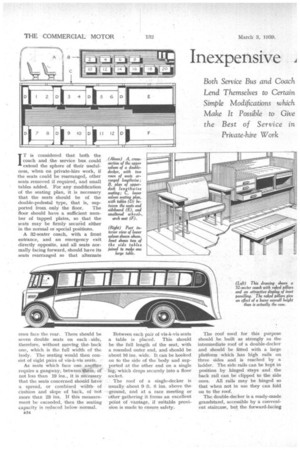Inexpensive aptability for Private-hire Work
Page 44

Page 45

If you've noticed an error in this article please click here to report it so we can fix it.
Both Service Bus and Coach Lend Themselves to Certain Simple Modifications which Make It Possible to Give the Best of Service in Private-hire Work
IT is considered that both the coach and the service bus could extend the sphere of their usefulness, when on private-hire work, if the seats could be rearranged, other seats removed if required, and small tables added. For any modification• of the seating plan, it is necessary that the seats should be of the double-pedestal type, that is, sup
ported from only the floor. The floor should have a sufficient number of tapped plates, so that the seats may be firmly secured either in the normal or special positions.
A 32-seater coach, with a front entrance, and an emergency exit directly opposite, and all seats normally facing forward, should have its seats rearranged so that alternate ones face the rear. There should be seven double seats on each side, therefore, without moving the% back one, which is the full width of the body. The seating would then consist of eight pairs of vis-a-vis seats.
As seats which face one anothbr
-41'" require a gangway, between M •
not less than 19 ins., it it ne:Cessary that the seats concerned shouldhave
a spread, or combined width of • cushion and slope of back, of not more than 23 ins. If this measurement be exceeded, then the seating capacity is reduced below normal.
534 Between each pair of vis-a-vis seats a table is placed. This should be the full length of the seat, with a rounded outer end, and should be about 16 ins. wide. It can be hooked on to the side of the 'body and supported at the other end on a single leg; which drops securely into a floor socket.
The roof of a single-decker is usually about 9 ft. 6 ins, above the '.,ground, and at a race meeting or
• other gathering it forms an excellent point of vantage, if •suitable provision is made to ensure safety. The roof used for this purpose should be built as strongly as the intermediate roof of a double-decker and should be fitted with a large platform which has high rails on three sides and is reached by a ladder. The side rails can be kept in position by hinged stays and the back rail can be clipped to the side ones. All rails may be hinged so that when not in use they can fold on to the roof.
The double-decker is a ready-made grandstand, accessible by a convenient staircase, but the forward-facing seats are not in the best position for this special use of the upper deck.
In order that a good broadside view may be afforded, some of the seats can be removed and the others set out lengthwise, in two rows facing the same side of the bus. There is then a gangway of about 12 ins. between the side of the body and the front row of seats. The second row is placed behind the front one, at the usual distance of forward-facing seats of about 2 ft. 6 ins. There is another gangway, between the second row of seats and the other side of the body, and each double seat may be separated from its neighbour, so that a series of crossgangways is formed, With the usual length of upper saloon, and allowing plenty of space at the top landing, it will be pos sible to arrange seats, in this manner, for 20 passengers. More seating can be provided by reducing the number of cross-gangways, such as putting two seats together to make a long seat for four persons.
The lower saloon of a doubledecker may be converted so that a party of from 12 to 15 persons may partake of a cold luncheon, or tea, in comfort. In this instance, only six of the forward-facing seats are used, and they are rearranged lengthwise and face one another across a wide gangway. The refreshments are placed on small side tables, about 9 ins, wide, each of which has a lower shelf below the table-top. Each double seat has one of these tables at each end of it. If larger tables be preferred for , use in the gangway, then two of them are joined together by means of dowels and plates or some other simple fastening, so that each double table measures 18 ins, wide and 2 ft. 9 ins. long. If these tables be placed in the gangway, then there will be room for another double seat, arranged lengthwise on each side of the lower saloon.
For the serving of meals and the storage of provisions, one of the
cushions of the lengthwise wheel-arch seats can be removed, so that the base. may support a sideboard. The last-mentioned may have a lower compartment, consisting of a nest of drawers for cutlery, and so on, and a cupboard enclosed by a pair of roller shutters. The -kip of this compartment can form a sideboard about 5 ft. long and 2 ft. wide, boarded at the ends and back, so that the Windows of the lower saloon are well protected.
The wheel-arch opposite to the sideboard may be used for a similar purpose, or may be left in its normal condition and thus afford seating for three or four additional persons.
There is always the question of the pay-load to be considered when arranging unusual features in coach appointment. An operator naturally wishes to carry as many passengers as possible consistent with providing adequate comfort, but in the case of private-hire work 1 an operator can base his charges on the convenience which his machines afford.




















































































